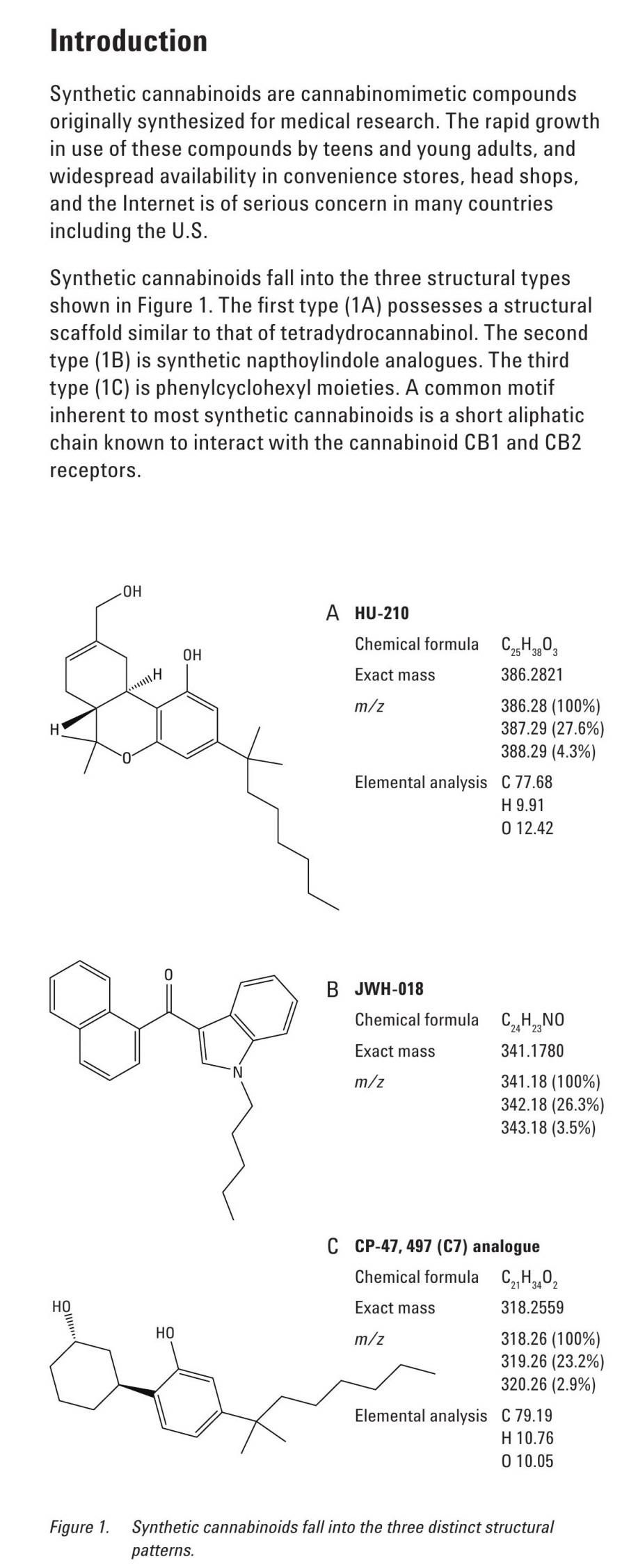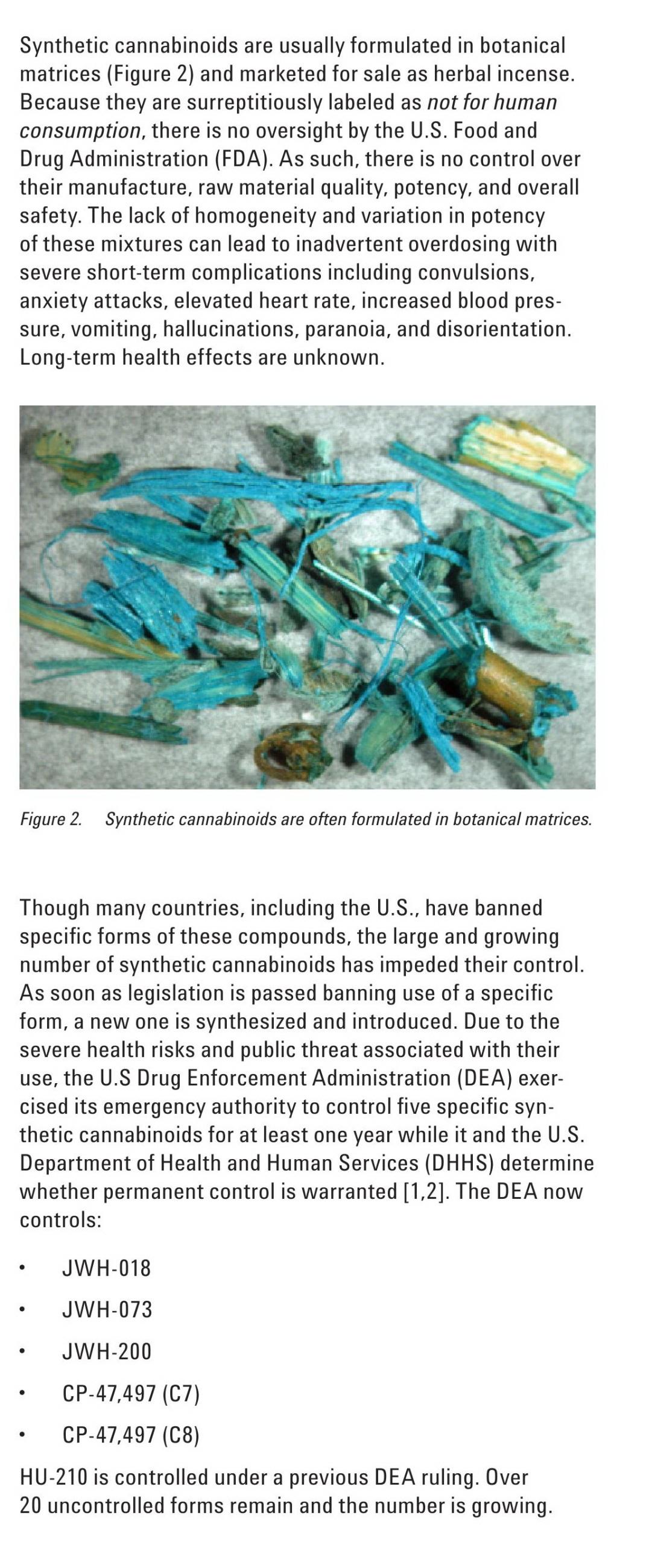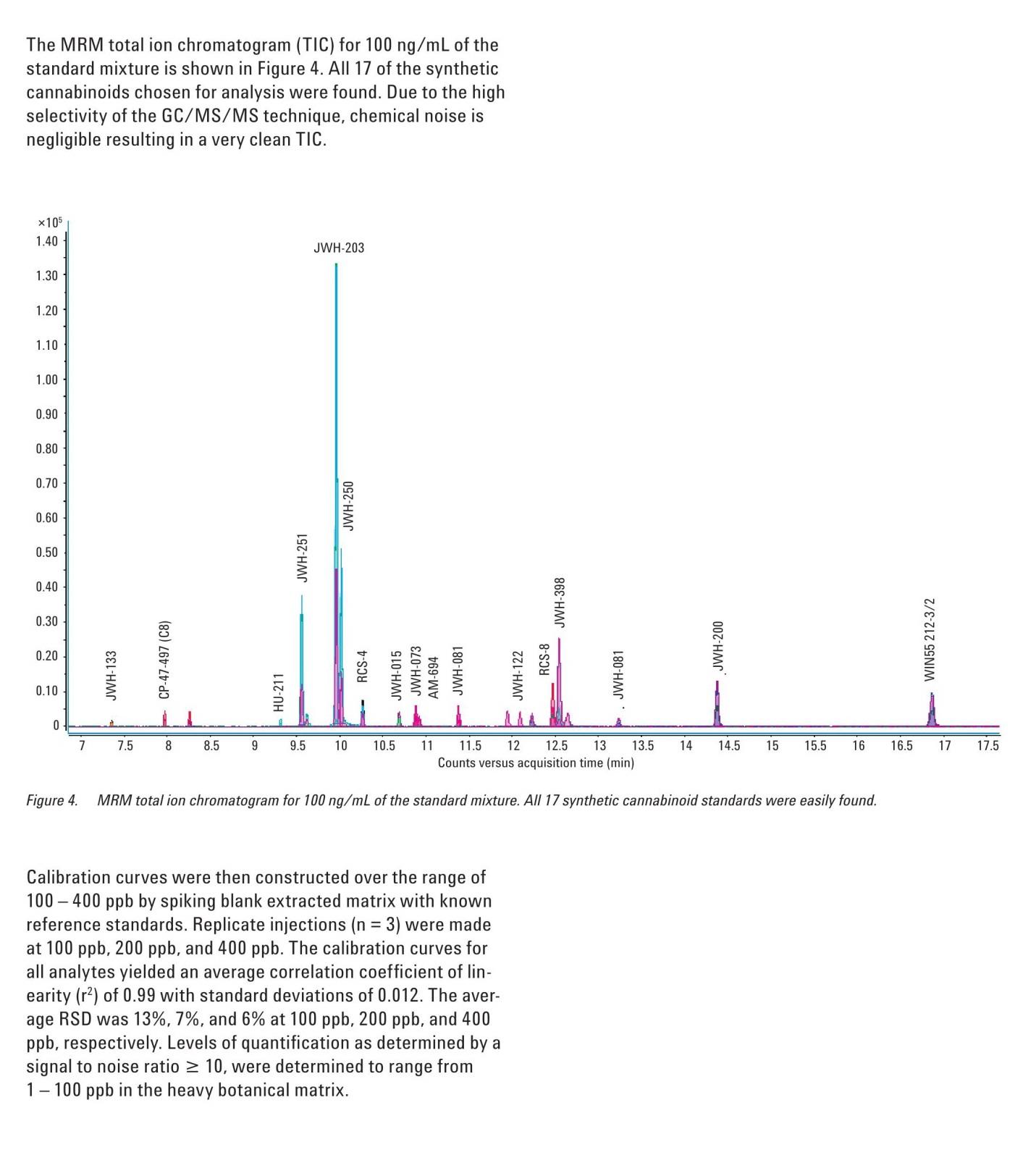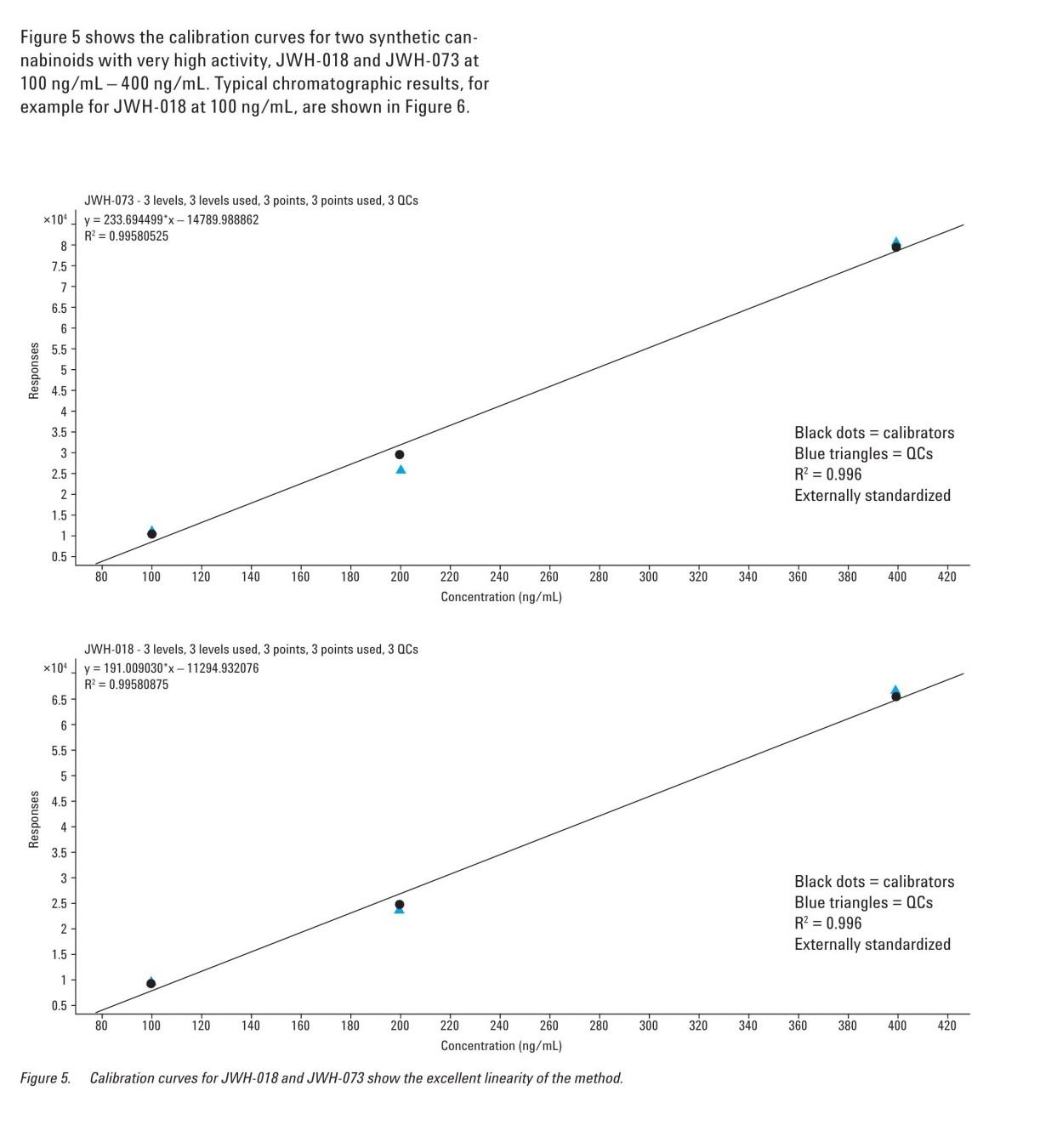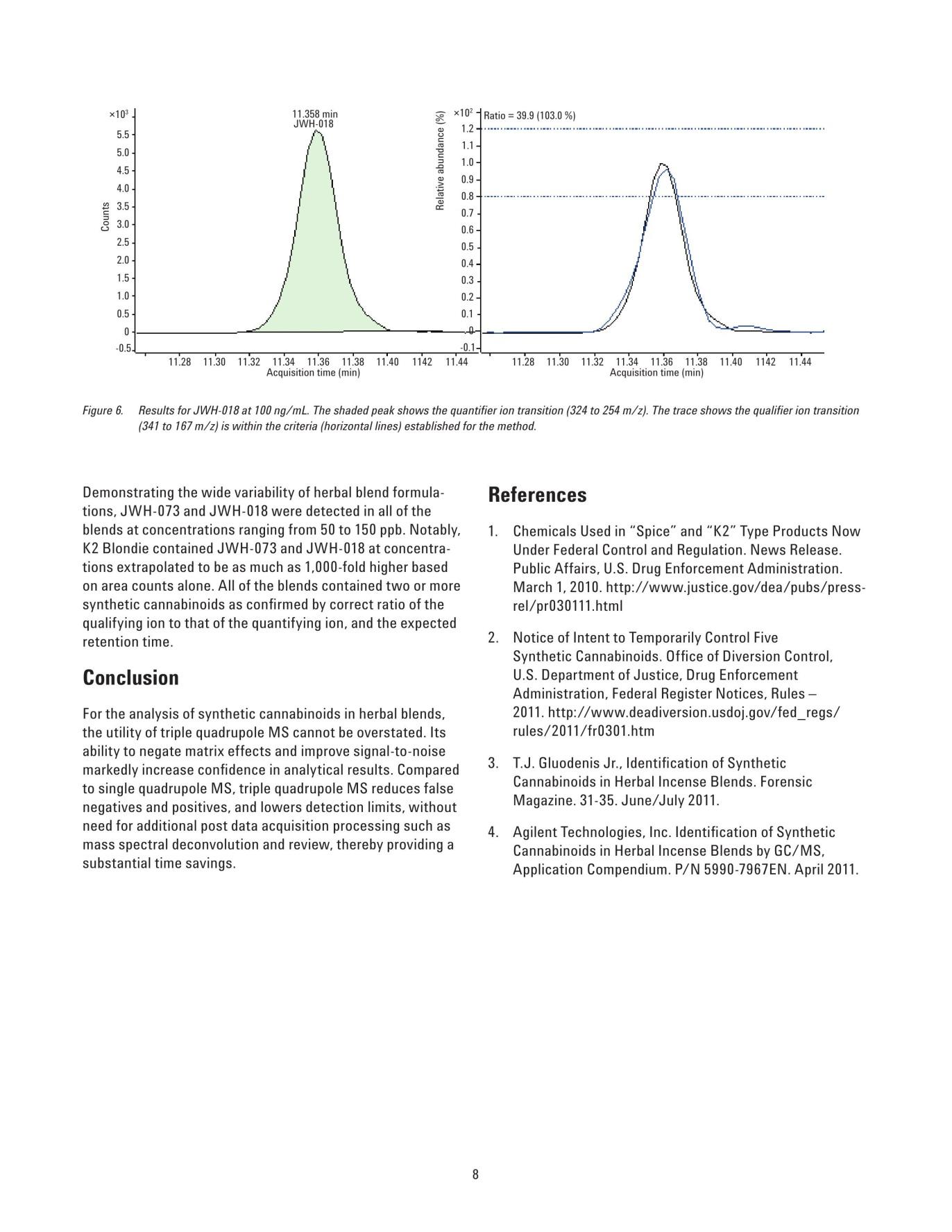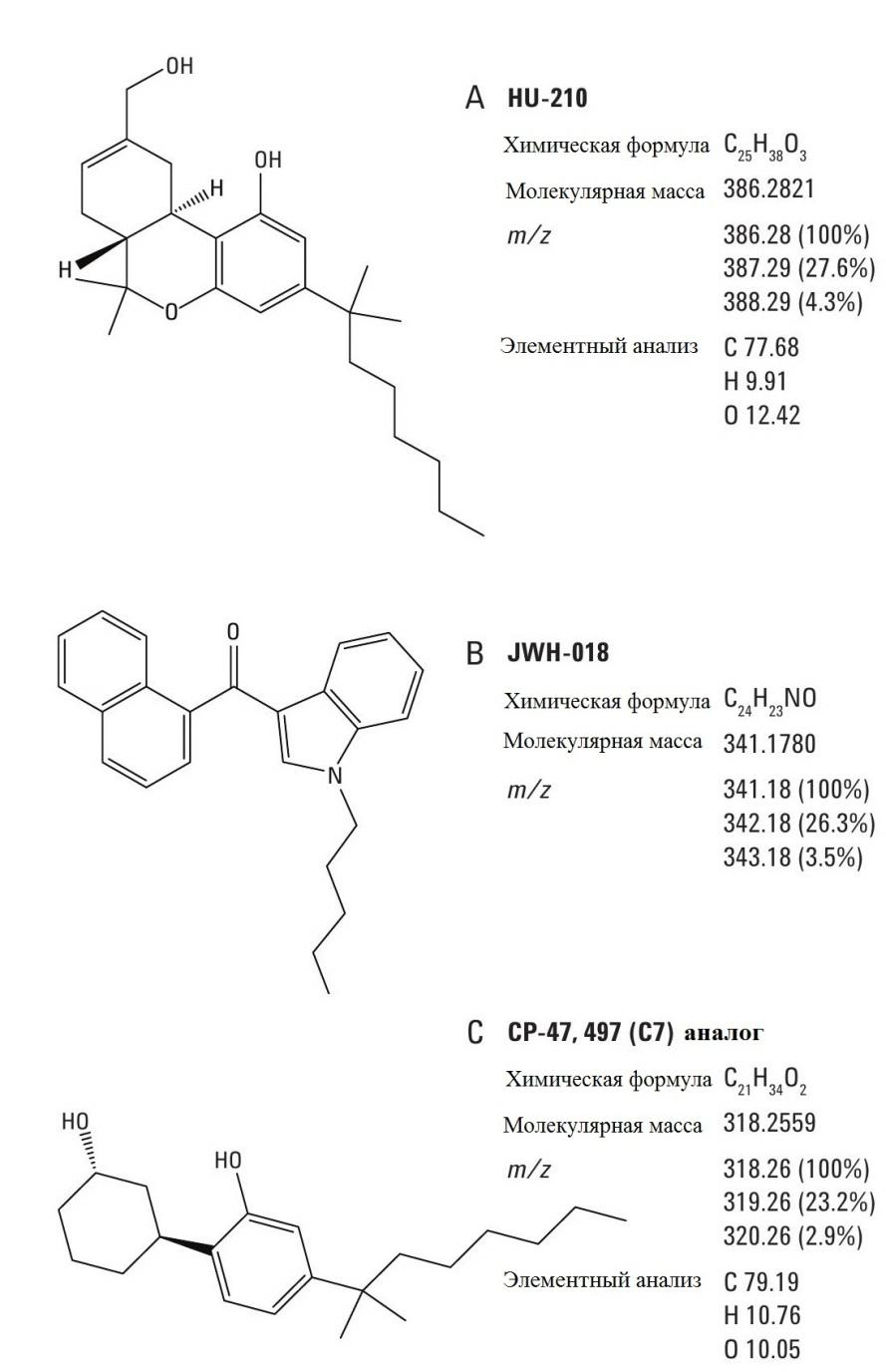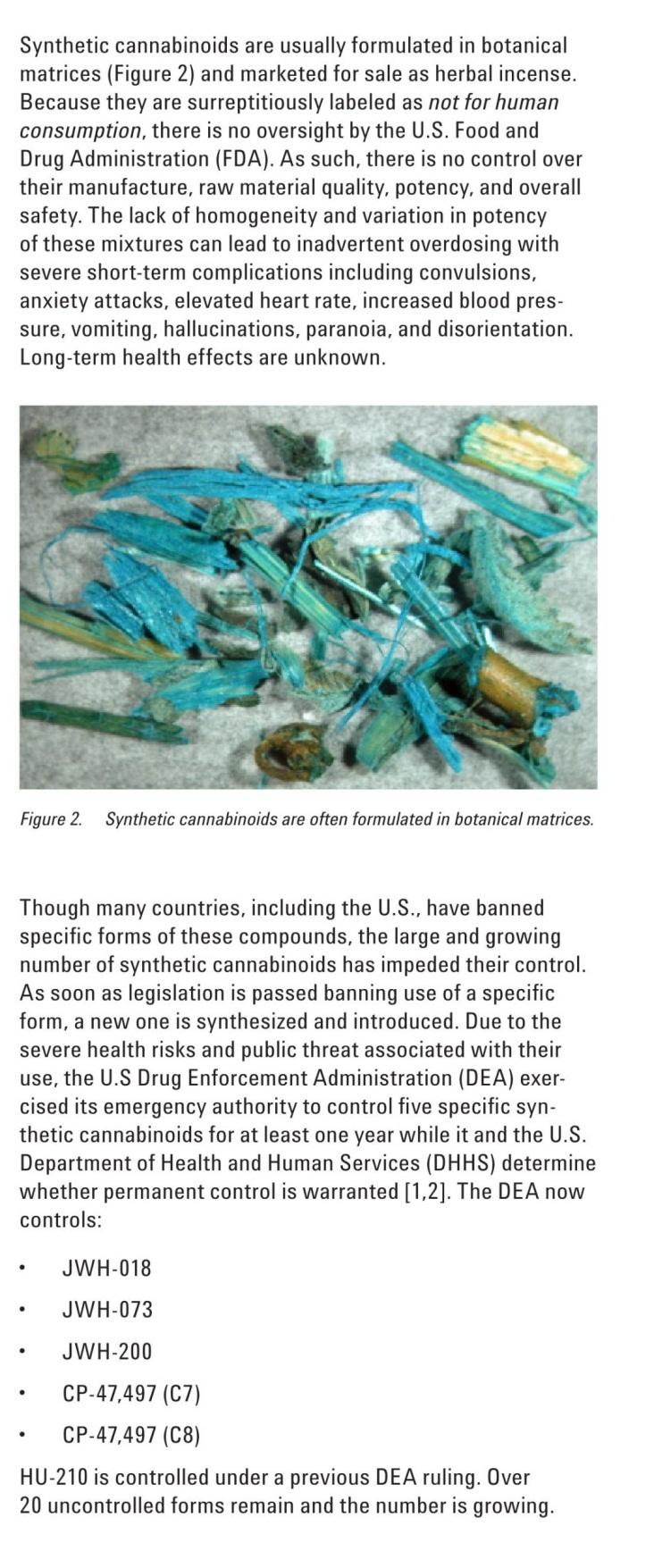
Статья 1
.docx|
CONFIRMATION AND QUANTIFICATION OF SYNTHETIC CANNABINOIDS IN HERBAL INCENSE BLENDS BY TRIPLE QUADRUPOLE GC/MS Application Note Forensics Authors Anthony Macherone, Ph.D. Thomas J. Gluodenis, Jr., Ph.D. Agilent Technologies, Inc. 2850 Centerville Road, Wilmington, DE 19808, USA Abstract With the rapid and dangerous growth in popularity of herbal incense blends containing synthetic cannabinoids, today's forensic laboratories are challenged to confirm and quantify the controlled forms at trace levels in complex matrices with confidence. Here, a representative sample of 17 of the more than 30 known synthetic cannabinoids is analyzed to demonstrate the applicability of a Triple Quadrupole GC/MS method. The method's selectivity reduces matrix effects and improves signal-to-noise, significantly increasing confidence in analytical results. The method also eliminates the need for post data-acquisition processing such as mass spectral deconvolution.
Introduction Synthetic cannabinoids are cannabinomimetic compounds originally synthesized for medical research. The rapid growth in use of these compounds by teens and young adults, and widespread availability in convenience stores, head shops, and the Internet is of serious concern in many countries including the U.S.
Synthetic cannabinoids fall into the three structural types shown in Figure 1. The first type (1A) possesses a structural scaffold similar to that of tetradydrocannabinol. The second type (1B) is synthetic napthoylindole analogues. The third type (1С) is phenylcyclohexyl moieties. A common motif inherent to most synthetic cannabinoids is a short aliphatic chain known to interact with the cannabinoid CB1 and CB2 receptors.
Figure 1. Synthetic cannabinoids fall into the three distinct structural patterns.
Synthetic cannabinoids are usually formulated in botanical matrices (Figure 2) and marketed for sale as herbal incense. Because they are surreptitiously labeled as not for human consumption, there is no oversight by the U.S. Food and Drug Administration (FDA). As such, there is no control over their manufacture, raw material quality, potency, and overall safety. The lack of homogeneity and variation in potency of these mixtures can lead to inadvertent overdosing with severe short-term complications including convulsions, anxiety attacks, elevated heart rate, increased blood pressure, vomiting, hallucinations, paranoia, and disorientation. Long-term health effects are unknown.
Figure 2. Synthetic cannabinoids are often formulated in botanical matrices.
Though many countries, including the U.S., have banned specific forms of these compounds, the large and growing number of synthetic cannabinoids has impeded their control. As soon as legislation is passed banning use of a specific form, a new one is synthesized and introduced. Due to the severe health risks and public threat associated with their use, the U.S Drug Enforcement Administration (DEA) exercised its emergency authority to control five specific synthetic cannabinoids for at least one year while it and the U.S. Department of Health and Human Services (DHHS) determine whether permanent control is warranted [1,2]. The DEA now controls: • JWH-018 • JWH-073 • JWH-200 • CP-47,497(C7) • CP-47,497 (C8)
HU-210 is controlled under a previous DEA ruling. Over 20 uncontrolled forms remain and the number is growing.
Confirmation and quantification of synthetic cannabinoid analogs and homologs by single quadrupole gas chromatography/mass spectrometry (GC/MS) presents numerous analytical challenges. At the outset, the botanical matrix is surprisingly difficult to homogenize. Subsequent extraction requires a general approach because synthetic cannabinoids contain a variety of functional groups. However, a general approach extracts a large amount of matrix substances which in turn produce a complex chromatogram with a substantial number of peaks. The blends often contain a mixture of synthetic cannabinoids which, due to their structural similarities and isomeric forms, co-elute producing overlapped mass spectra. Adding to the challenge, synthetic cannabinoids can be extremely potent and thus present at trace levels relative to the matrix. Though previously demonstrated as an effective and easy to replicate approach [3, 4], single quadrupole GC/MS analyses of these matrices yields very complex data that requires significant effort to interpret without the help of special post acquisition processing software, for example mass spectral deconvolution software.
In this application, a representative sample of an herbal blend is analyzed for the presence of synthetic cannabinoids to demonstrate the applicability of an alternative GC/MS/MS approach that offers enhanced selectivity and sensitivity, and that eliminates the need for mass spectral deconvolution. Experimental Reference standards and samples Listed in Table 3, seventeen of the more than 30 known synthetic cannabinoids were chosen for the development of the GC/MS/MS method. These compounds were chosen to capture the structural diversity of synthetic cannabinoids found in popular herbal blends.
The herbal blends analyzed were EX 565, K2 Blondie, K4 Purple Haze, КЗ ХХХ, Lunar Diamond, Zombie, and K2 Diamond. Sample Preparation Homogenization The botanical material used as the carrier for synthetic cannabinoids, for example Damiana (Turnera diffusa), is soft and light. These properties make it difficult to crush into a homogenous form for representative sampling. For this analysis, approximately 500 mg of sample was ground between two 5 inch by 5 inch sheets of 100-grit sandpaper until a finely divided powder was obtained. Extraction The multiple functional groups associated with synthetic cannabinoids necessitate a generalized extraction approach. For this analysis, an acid/base combined extraction followed by centrifugation was employed. It is also possible to perform the extraction using methanol incubation. Either approach will extract substantial amounts of matrix components.
Using the acid/base approach, an aliquot of homogenized sample (50 - 100 mg) was acidified by adding 1 mL of de-ionized water, followed by three drops of 10% hydrochloric acid. Next, 1 mL of solvent (95% methylene chloride/5% isopropanol v/v) was added and the sample mixed. The sample was then centrifuged and the bottom solvent layer retained and set aside. Two drops of concentrated ammonium hydroxide and 1 mL of the solvent (95% methylene chloride/5% isopropanol v/v) were added to the remaining aqueous mixture (top layer). The sample was mixed and centrifuged again. The bottom solvent layer was removed, combined with the first bottom solvent layer collected, and then mixed briefly. The sample was then ready for GC/MS/MS analysis.
Derivatization Some synthetic cannabinoids, for example HU-210, contain multiple, active, polar functional groups such as phenols and alcohols, which can make them much less amenable to GC/MS analysis. To enhance the chromatographic performance and sensitivity of the method for these compounds, derivatization with BSTFA (N,o-Bis (Trimethylsilyl) trifluoroacetamide) with 1% TMCS (trimethylchlorosilane) can be used to cap the functional groups and to produce more intense ions for identification and quantification. Derivatization is not required for the analysis presented in this application note. GC/MS/MS Analysis The GC/MS/MS analyses were performed on an Agilent 7000 Series Triple Quadrupole GC/MS system which couples the Agilent 7890A Gas Chromatograph with the Agilent 7000B Mass Spectrometer. The Agilent 7890A Gas Chromatograph was equipped with a HP-5MS UI column. Table 1 lists the Gas Chromatograph run conditions. The Agilent 7000B Mass Spectrometer was operated in electron impact ionization (EI) MS/MS mode using multiple reaction monitoring (MRM) for all analytes and reference standards. Table 2 lists the Mass Spectrometer operating conditions. Table 1. Gas Chromatograph Run Conditions
Table 2. Mass Spectrometer Operating Conditions
MRM transitions were developed empirically beginning with the collection of full-scan spectra from the reference standards, followed by product ion scanning to identify optimal precursor/product ion pairs for the analysis. Next, the collision cell energy was optimized to achieve the maximum ion intensity for each unique transition. Table 3 provides the analyte list with the associated precursor and product ions, and the optimized collision energies. Table 3. Analyte List with Associated Precursor and Product Ions, Optimized Collision Energies, and Retention Times
Results and Discussion In a GC/MS/MS MRM experiment, the target analyte is selectively isolated from the matrix. As shown in Figure 3, the first quadrupole mass filter isolates a single precursor ion which is allowed to pass into the collision cell. In the collision cell, the precursor ion is fragmented by a collision gas and an applied electrical voltage - a process called collision induced dissociation (CID). CID fragments the precursor ion into specific and predictable product ions. The second quadrupole mass filter is set to pass only the specific product ions designated by the user. The most intense ion, the quantifier ion, is used for quantification. The qualifier ion, when found in the correct abundance ratio with the quantifier, is used for confirmation.
Figure 3. Multiple reaction monitoring (MRM) technique. Even if an interfering ion is inadvertently allowed to pass through the first quadrupole into the collision cell, the likelihood that the interfering ion would yield the same product ions as the analyte precursor ion is extremely low. In this manner, chemical noise is entirely separated from signal, increasing the signal-to-noise ratio and thus sensitivity. Compared to performing selected ion monitoring (SIM) using a single quadrupole mass spectrometer, the MRM technique made possible by GC/MS/MS systems offers significantly improved selectivity and sensitivity for the detection of trace-level synthetic cannabinoids in complex matrices such as herbal incense blends. The MRM total ion chromatogram (TIC) for 100 ng/mL of the standard mixture is shown in Figure 4. All 17 of the synthetic cannabinoids chosen for analysis were found. Due to the high selectivity of the GC/MS/MS technique, chemical noise is negligible resulting in a very clean TIC.
Figure 4. MRM total ion chromatogram for 100 ng/mL of the standard mixture. All 17 synthetic cannabinoid standards were easily found. Calibration curves were then constructed over the range of 100 - 400 ppb by spiking blank extracted matrix with known reference standards. Replicate injections (n = 3) were made at 100 ppb, 200 ppb, and 400 ppb. The calibration curves for all analytes yielded an average correlation coefficient of linearity (r2) of 0.99 with standard deviations of 0.012. The average RSD was 13%, 7%, and 6% at 100 ppb, 200 ppb, and 400 ppb, respectively. Levels of quantification as determined by a signal to noise ratio > 10, were determined to range from 1 -100 ppb in the heavy botanical matrix. Figure 5 shows the calibration curves for two synthetic cannabinoids with very high activity, JWH-018 and JWH-073 at 100 ng/mL-400 ng/mL. Typical chromatographic results, for example for JWH-018 at 100 ng/mL, are shown in Figure 6.
Figure 5. Calibration curves for JWH-018 and JWH-073 show the excellent linearity of the method.
Figure 6. Results for JWH-018 at 100 ng/mL. The shaded peak shows the quantifier ion transition (324 to 254 m/z). The trace shows the qualifier ion transition (341 to 167 m/z) is within the criteria (horizontal lines) established for the method. Demonstrating the wide variability of herbal blend formulations, JWH-073 and JWH-018 were detected in all of the blends at concentrations ranging from 50 to 150 ppb. Notably, K2 Blondie contained JWH-073 and JWH-018 at concentrations extrapolated to be as much as 1,000-fold higher based on area counts alone. All of the blends contained two or more synthetic cannabinoids as confirmed by correct ratio of the qualifying ion to that of the quantifying ion, and the expected retention time. Conclusion For the analysis of synthetic cannabinoids in herbal blends, the utility of triple quadrupole MS cannot be overstated. Its ability to negate matrix effects and improve signal-to-noise markedly increase confidence in analytical results. Compared to single quadrupole MS, triple quadrupole MS reduces false negatives and positives, and lowers detection limits, without need for additional post data acquisition processing such as mass spectral deconvolution and review, thereby providing a substantial time savings. References 1. Chemicals Used in "Spice" and "K2" Type Products Now Under Federal Control and Regulation. News Release. Public Affairs, U.S. Drug Enforcement Administration. March 1, 2010. http://www.justice.gov/dea/pubs/press-rel/pr030111.html 2. Notice of Intent to Temporarily Control Five Synthetic Cannabinoids. Office of Diversion Control, U.S. Department of Justice, Drug Enforcement Administration, Federal Register Notices, Rules - 2011. http://www.deadiversion.usdoj.gov/fed_regs/ rules/2011/fr0301.htm 3. T.J. Gluodenis Jr., Identification of Synthetic Cannabinoids in Herbal Incense Blends. Forensic Magazine. 31-35. June/July 2011. 4. Agilent Technologies, Inc. Identification of Synthetic Cannabinoids in Herbal Incense Blends by GC/MS, Application Compendium. P/N 5990-7967EN. April 2011. Acknowledgement The authors would like to thank the National Medical Services (NMS) Laboratory (Willow Grove, PA) for graciously providing the herbal blend extracts used in this study. The authors would also like to acknowledge Fran Diamond of NMS for the development of the sample preparation and extraction methodologies. For More Information These data represent typical results. For more information on our products and services, visit our Web site at www.agilent.com/chem. www.agilent.com/chem Agilent shall not be liable for errors contained herein or for incidental or consequential damages in connection with the furnishing, performance, or use of this material. Information, descriptions, and specifications in this publication are subject to change without notice. © Agilent Technologies, Inc., 2012 Printed in the USA January 17, 2012 5990-8987EN
|
ИДЕНТИФИКАЦИЯ И КОЛИЧЕСТВЕННОЕ ОПРЕДЕЛЕНИЕ СИНТЕТИЧЕСКИХ КАННАБИНОИДОВ В ТРАВЯНЫХ КУРИТЕЛЬНЫХ СМЕСЯХ МЕТОДОМ ГХ/МС С ТРОЙНЫМ КВАДРУПОЛЬНЫМ МАСС-АНАЛИЗАТОРОМ Предъявительская записка Судебная экспертиза Авторы Anthony Macherone, Ph.D. Thomas J. Gluodenis, Jr., Ph.D. Agilent Technologies, Inc. 2850 Centerville Road, Wilmington, DE 19808, USA Аннотация В связи с быстрым и опасным ростом популярности травяных курительных смесей, перед специалистами судебных лабораторий встал вопрос достоверной идентификации и определения следовых количеств запрещенных синтетических каннабиноидов. В данной статье продемонстрирован анализ 17 различных синтетических каннабиноидов (всего на данный момент известно более 30 веществ этой группы) методом ГХ/МС с тройным квардупольным масс-анализатором, что подтверждает применимость разработанной методики для поставленной выше задачи. Селективность методики обеспечила уменьшение матричных эффектов и увеличение отношения сигнал/шум, что значительно повысило точность аналитических результатов. Наконец, разработанная методика не требует такой дополнительной обработки полученных данных, как масс-спектрометрическая деконволюция. Введение Изначально синтетические каннабиноиды, или каннабимиметики, получали для различного рода медицинских исследований. Растущая популярность употребления этих веществ среди подростков и молодежи в совокупности с их широкой доступностью в мини-маркетах, специализированных магазинах и Интернете представляет серьезную проблему во многих странах, включая США. Синтетические каннабиноиды подразделяют на три структурных типа (рис. 1). Первый тип (1A) составляют тетрагидроканнабинол и его производные. Синтетические каннабиноиды второго типа (1B) – нафтоилиндол и его аналоги. Третий тип (1С) включает в себя вещества, повторяющие структуру циклогексилфенола. Общим фрагментом молекулы для большинства синтетических каннабиноидов является короткая алифатическая цепь, которая и обеспечивает взаимодействие этой группы веществ с каннабиноидными рецепторами CB1 и CB2.
Рис. 1. Три структурных типа синтетических каннабиноидов.
Обычно носителем синтетических каннабиноидов являются растительные матрицы, поступающие в продажу в качестве благовоний (рис. 2). Номинально заявленные как благовония, эти смеси при их использовании для курения, оказывают выраженное психотропное действие, подобное эффекту марихуаны, но поскольку они маркированы как товар, не предназначенный для употребления человеком, данная продукция находится вне юрисдикции Управления по контролю качества пищевых продуктов и лекарственных средств (Food and Drug Administration, FDA) США. В этой связи полностью отсутствует контроль производственного процесса, качества сырья, содержания активных веществ и безопасности. Неоднородность этих смесей и, как следствие, неравномерное распределение активных веществ, может привести к случайной передозировке с такими серьезными краткосрочными осложнениями, как конвульсии, панические атаки, учащение сердечного ритма, повышение кровяного давления, рвоту, галлюцинации, паранойю и дезориентацию. Физиологические эффекты, возникающие при долгосрочном употреблении смесей с синтетическими каннабиноидами, неизвестны.
Рис. 2. Растительная матрица – носитель синтетических каннабиноидов. Несмотря на то, что во многих странах, включая США, был введен запрет на ряд веществ этой группы, контроль над ними затрудняется весьма интенсивным ростом числа наименований синтетических каннабиноидов. Как только принимается закон о запрете одной формы, синтезируют очередной ее аналог. Из-за серьезного риска для здоровья и общественной угрозы, связанной с употреблением этих веществ, Администрация по контролю за соблюдением законов о наркотиках (Drug Enforcement Administration, DEA) США, воспользовавшись своими чрезвычайными полномочиями по расширению списков контролируемых веществ, установила временный контроль (минимум на протяжении одного года) над пятью синтетическими каннабиноидами. В течение установленного срока Министерством здравоохранения и социального обеспечения (Department of Health and Human Services, DHHS) будет рассматриваться вопрос о переводе отмеченных веществ на постоянный контроль [1,2]. Данную группу составляют следующие синтетические каннабиноиды: • JWH-018 • JWH-073 • JWH-200 • CP-47,497(C7) • CP-47,497 (C8) Ранее уже было принято постановление о контроле за оборотом HU-210, однако более 20 форм, являющихся аналогом этого вещества, все еще остаются вне юрисдикции DEA, и число их неуклонно растет. Идентификация и количественное определение синтетических каннабиноидов и их гомологов методом ГХ/МС с одинарным квадрупольным масс-анализатором осложнены многочисленными аналитическими проблемами. Для начала, растительную матрицу достаточно трудно гомогенизировать. Последующая экстракция требует какого-то общего подхода, так как синтетические канабиноиды содержат множество разнообразных функциональных групп. Такой подход приводит к тому, что извлекается большое количество матричных веществ, усложняющих интерпретацию хроматограммы из-за значительного числа пиков. Исследуемые смеси часто содержат несколько синтетических каннабиноидов, которые за счет общности структуры и наличия изомерных форм элюируются совместно, в результате чего масс-спектры перекрываются. Кроме того, синтетические каннабиноиды как чрезвычайно активные вещества зачастую присутствуют в следовых количествах относительно матрицы. Несмотря на то, что ранее в литературе данный подход позиционировался как весьма эффективный и легко осуществляемый [3, 4], результаты, получаемые методом ГХ/МС с одинарным квадрупольным масс-анализатором, трудно интерпретировать, поэтому требуется дополнительная обработка данных посредством специализированного программного обеспечения, в частности, масс-спектрометрическая деконволюция. На основании вышесказанного, для анализа пробы травяной смеси на предмет присутствия синтетических каннабиноидов, был разработан альтернативный ГХ/МС/МС подход, который не только продемонстрировал свою принципиальную применимость к данной задаче, но и благодаря большей селективности и чувствительности позволил избавиться от необходимости в масс-спектрометрической деконволюции. Экспериментальная часть Стандартные и исследуемые образцы На сегодняшний день известно более 30 синтетических каннабиноидов, в табл. 3 представлены 17 форм, использовавшихся при разработке ГХ/МС/МС методики. Данный выбор был обусловлен стремлением максимально охватить то структурное разнообразие синтетических каннабиноидов, что представлено в популярных травяных смесях. Для анализа были выбраны следующие марки травяных смесей: «EX 565», «K2 Blondie», «K4 Purple Haze», «КЗ ХХХ», «Lunar Diamond», «Zombie» и «K2 Diamond». Подготовка проб Гомогенизация Растительный материал, используемый в качестве носителя синтетических каннабиноидов, например, Дамиана, или Тернера раскидистая (Turnera diffusa), мягкий и легкий. Эти свойства усложняют процесс гомогенизации и препятствуют получению представительной пробы. Для достижения гомогенности около 500 мг материала помещали между двумя листами наждачной бумаги (зерно 100) размером 12,7 на 12,7 см и растирали до получения мелкодисперсного порошка. Экстракция Из-за наличия в структуре синтетических каннабиноидов различных функциональных групп возникает необходимость прибегать к общим подходам при экстракции. В данной методике кислотно-основное экстрагирование совмещали с центрифугированием. Также экстракция может осуществляться выдерживанием сырья в метаноле. При любом из данных подходов помимо целевого вещества будет извлекаться значительное количество матричных компонентов. Кислотно-основное экстрагирование осуществляли следующим образом: аликвоту гомогенизированного образца (50 - 100 мг) подкисляли 1 мл деионизированной воды с тремя каплями 10% соляной кислоты. Затем 1 мл растворителя (95 об.% хлористого метилена, 5 об.% изопропанола) добавляли к образцу и перемешивали. Далее смесь центрифугировали, после чего нижний слой растворителя был отделен и сохранен. К оставшемуся водному (верхнему) слою растворителя добавляли две капли концентрированного гидроксида аммония и 1 мл растворителя (95 об.% хлористого метилена, 5 об.% изопропанола), перемешивали и снова центрифугировали. Нижний слой растворителя отделяли, объединяли с первой порцией и в течение непродолжительного периода времени перемешивали. Далее образец анализировали методом ГХ/МС/МС. Дериватизация Некоторые синтетические каннабиноиды, например, HU-210, содержат по несколько активных полярных функциональных групп, таких как фенольные и спиртовые гидроксильные, которые уменьшают чувствительность ГХ/МС метода. Для повышения производительности методики и ее чувствительности к данным компонентам можно провести дериватизацию образца за счет взаимодействия с N,O-бис (триметилсилил) трифторацетамидом (BSTFA) и 1% триметилхлорсиланом. Эти агенты защищают функциональные группы и позволяют получить более интенсивный сигнал для идентификации и количественного определения целевых ионов. В случае использования ГХ/МС/МС методики, которой и посвящена данная статья, дериватизация не требуется. ГХ/МС/МС анализ Для ГХ/МС/МС анализа использовали хромато-масс-спектрометр Agilent 7000 с тройным квадрупольным масс-анализатором на основе газового хроматографа Agilent 7890A и масс-спектрометра Agilent 7000B (Agilent Technologies, США). В работе использовали капиллярную колонку HP-5MS Ultra Inert (Agilent Technologies, США). В табл.1 приведены условия хроматографирования. МС-детектирование испытуемых и стандартных образцов осуществляли методом электронной ионизации (EI) в режиме мониторинга множественных реакций (multiple reaction monitoring, MRM). В табл.2 приведены условия МС-детектирования. Табл.1. Условия хроматографирования
Табл.2. Условия МС-детектирования
Режим MRM был разработан эмпирически путем изучения полных спектров стандартных образцов с последующей регистрацией нескольких продуктов фрагментации исходного иона с целью выявления оптимальных для анализа пар родительских и дочерних ионов. На следующем этапе подбиралась энергия соударений, при которой интенсивности ионов для каждого из переходов были максимальными. В табл.3 представлены родительские и дочерние ионы, а также оптимальные энергии соударения для каждого из анализируемых веществ. Табл.3. Родительские и дочерние ионы, оптимальные энергии соударений и времена удерживания анализируемых веществ
Результаты и обсуждение
|
||||||||||||||||||||||||||||||||||||||||||||||||||||||||||||||||||||||||||||||||||||||||||||||||||||||||||||||||||||||||||||||||||||||||||||||||||||||||||||||||||||||||||||||||||||||||||||||||||||||||||||||||||||||||||||||||||||||||||||||||||||||||||||||||||||||||||||||||||||||||||||||||||||||||||||||||||||||||||||||||||||||||||||||||||||||||||||||||||||||||||||||||||||||||

